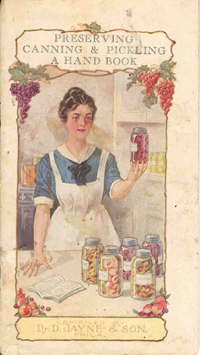|
|
|
|
 |
 |
|
|
Yooper Food
|
|
 |
|
 |
Pickles & Preserves
When people think of pickles, they usually think of cucumbers. In fact, Iíve spoken to people who didnít even know that pickles and cucumbers were the same vegetable.
 Back in the olden days however, before electric refrigerators and neighborhood supermarkets, people pickled and canned everything possible, not only cucumbers but also sausage, eggs, fish, vegetables, and fruit. What couldnít be pickled was often salted or canned. Back in the olden days however, before electric refrigerators and neighborhood supermarkets, people pickled and canned everything possible, not only cucumbers but also sausage, eggs, fish, vegetables, and fruit. What couldnít be pickled was often salted or canned.
In the rugged climate of the Upper Peninsula, the growing seasons were short and the winters were long, so it was necessary to put enough away to get through the winter and into the next season.
Women were judged on their ability to produce a tasty pickle, and mothers handed down pickle recipes from generation to generation. Except in rare families, this is no longer the case today.
We donít eat a lot of pickled foods, anymore. Cucumbers, being the most common, but you can also find pickled eggs, herring, and even pigs feet if you look hard enough.
Iíve never been overly fond of pickled cucumbers, particularly the sweet kind, but I love pickled eggs and, being of Swedish ancestry, Iíve always like gaffelbiter, which is a type of pickled herring but, when I can find it now, it comes in a can rather than a jar, as it used to, and it doesnít taste nearly as good as I remember it.
And, although I donít usually admit it publicly, I liked the pickled pigís feet too, but I had to look away and pretend that it was something else while I was eating it. In other words, itís not something Iíd order on a date.
Pickling Tips
Always follow pickle recipes exactly. Altering quantities - especially those of vinegar, vegetables, and salt - can lead to the spread of spoilage-causing bacteria. Scrupulously clean all cooking utensils in hot, soapy water. Rinse thoroughly.
|
 |
 |
 |
|
Produce
- Use crisp, blemish-free, fresh produce - if possible, within 24 hours of harvest. Wash thoroughly in running water.
- Refrigerate unused produce immediately.
Cucumbers
- Use fresh pickling cucumbers, not salad cucumbers. Donít use waxed cucumbers, as was prevents the pickling liquid from penetrating the cucumber. Donít use bruised or damaged cucumbers.
- Cucumbers go bad quickly, particularly at room temperature.
- Remove blossom and stem, and cut about 1/16 off the blossom end. The blossom releases enzymes that soften a cucumber.
- Wash cucumbers thoroughly in cool running water. Scrub with a soft vegetable brush to remove any dirt or sand granules.
Salt
- Always use pickling salt, not table salt. Table salt contains iodine, a chemical that can darken pickles. Anticaking agents in table salt can cause cloudiness in your brine.
Vinegar
- Use commercial white vinegar with at least 5% acidity. While cider and malt vinegars can add flavor subtleties, they also darken light-colored vegetables.
- You can also use ďpickling vinegarĒ (7% acidity) to make your pickles more sour.
|
|
|
|
|
|
 |
 |
 |
|
Water
- Use only soft water (water with low levels of minerals and chlorine). Hard water (water with high mineral levels) can lower brine acidity, possibly affecting food safety.
- To soften hard water, boil for 15 minutes, then allow it to stand covered for 24 hours. Remove any surface scum that forms. Carefully ladle the water from the pot without agitating the bottom sediment.
Spices
- Use fresh spices, whole, crushed, or ground. Avoid spices stored in your pantry for more than a year.
- Powdered spices can turn pickling liquid dark and cloudy.
- Tie whole spices in a spice bag, made from a large square of cheesecloth. Avoid using colored cloth.
- While premixed pickling spices are available in the supermarket, you may want to make your own mix. Just a few possibilities include cinnamon sticks, bay leaves, chili peppers, black peppercorns, yellow mustard seeds, fennel seeds, whole allspice, whole cloves, whole coriander, fenugreek, dill seeds, turmeric, celery seed, dill leaves, fresh or dried ginger, horseradish, garlic, and hot peppers.
Containers
- Use stainless steel, glass, or ceramic bowls. For pots and pans, use stainless steel, heatproof glass, or hard-anodized aluminum.
- Avoid containers and utensils made of copper, iron, zinc, or brass (these materials may react with acid and salt).
|
|
|
Visit our Sister Site: Pasties, Plain & Simple
|
|
|


 Back in the olden days however, before electric refrigerators and neighborhood supermarkets, people pickled and canned everything possible, not only cucumbers but also sausage, eggs, fish, vegetables, and fruit. What couldnít be pickled was often salted or canned.
Back in the olden days however, before electric refrigerators and neighborhood supermarkets, people pickled and canned everything possible, not only cucumbers but also sausage, eggs, fish, vegetables, and fruit. What couldnít be pickled was often salted or canned.